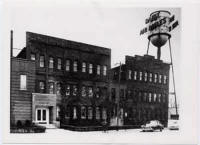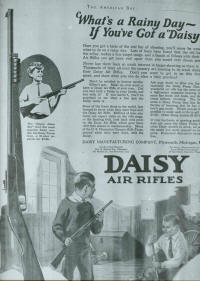| |
 |
|
 |
|

The Plymouth Michigan Plant |
|
 |
|
| |
 |
|
 |
|
In the early days of air rifles, shot tubes were
sized to utilize lead drop shot that was
approximately .180 inches in diameter; a size
referred to as “BB”, hence the name “BB gun”.
Shortly after the turn of the century, seeing the
potential in the air gun ammo business, Daisy
prevailed upon the makers of lead shot to create a
special size ball with an average diameter of .175
inches and call it “”Air Rifle Shot”. However, the
name “BB” stuck and is still in common use today.
In the mid 1920’s Daisy began to
experience an unusually high rate of returns the
source of which was ultimately traced to the
American Ball Company in Minneapolis, Minnesota, a
manufacturer of steel ball bearings. Apparently,
enterprising young lads in the area were salvaging
bearings from the scrap out back of the plant to
shoot in their guns. While some scrap worked well
in the guns, some was oversize and either jammed or
split the shot tube. When this was called to the
attention of American Ball Company, some quick
market research on their part revealed that there
was a bigger market for air rifle shot than for
their particular brand of bearings. Armed with this
information they began manufacturing and selling
steel balls in a size approximating air rifle shot
under the brand name “Bulls Eye”.
Because steel shot was less expensive
to manufacture and performed better due to its
lighter weight, sales skyrocketed. Quick to realize
their return problems were only going to compound
Daisy redesigned its shot tubes to accommodate the
“Bulls Eye” ammo and negotiated an agreement to
become the exclusive sales agent for American Ball.
The arrangement continued smoothly until Daisy,
acquired the assets of American Ball Company in
early 1939.
1880 ║ 1890 ║
1900 ║
1910 ║
1920
║ 1930 ║
1940 ║
The War Years
1950 ║
1960 ║
1970 ║
1980 ║
1990 ║
2000 ║
The Museum
|

